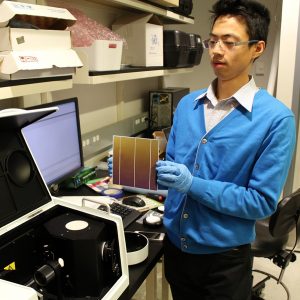 New solar energy research from Arizona State University demonstrates that silicon-based tandem photovoltaic modules, which convert sunlight to electricity with higher efficiency than present modules, will become increasingly attractive in the U.S.
A paper that explores the costs vs. enhanced efficiency of this new solar technology appears in Nature Energy this week. The paper is authored by ASU Ira A. Fulton Schools of Engineering Assistant Research Professor Zhengshan J. Yu, graduate student Joe V. Carpenter and Assistant Professor Zachary Holman.
The Department of Energy’s SunShot Initiative was launched in 2011 with a goal of making solar cost-competitive with conventional energy sources by 2020. The program attained its goal of $0.06 per kilowatt-hour three years early, and a new target of $0.03 per kilowatt-hour by 2030 has been set. Increasing the efficiency of photovoltaic modules is one route to reducing the cost of the solar electricity to this new target. If reached, the goal is expected to triple the amount of solar installed in the U.S. in 2030 compared to the business-as-usual scenario.
Holman’s research group is a leader in silicon-based tandem photovoltaic technologies, having held the efficiency world record in collaboration with Stanford University for a perovskite/silicon tandem solar cell until last month. As the team strives to reclaim the record while sticking to inexpensive materials and simple processes, it now knows that its innovations will likely find their way to a U.S. rooftop.
New solar energy research from Arizona State University demonstrates that silicon-based tandem photovoltaic modules, which convert sunlight to electricity with higher efficiency than present modules, will become increasingly attractive in the U.S.
A paper that explores the costs vs. enhanced efficiency of this new solar technology appears in Nature Energy this week. The paper is authored by ASU Ira A. Fulton Schools of Engineering Assistant Research Professor Zhengshan J. Yu, graduate student Joe V. Carpenter and Assistant Professor Zachary Holman.
The Department of Energy’s SunShot Initiative was launched in 2011 with a goal of making solar cost-competitive with conventional energy sources by 2020. The program attained its goal of $0.06 per kilowatt-hour three years early, and a new target of $0.03 per kilowatt-hour by 2030 has been set. Increasing the efficiency of photovoltaic modules is one route to reducing the cost of the solar electricity to this new target. If reached, the goal is expected to triple the amount of solar installed in the U.S. in 2030 compared to the business-as-usual scenario.
Holman’s research group is a leader in silicon-based tandem photovoltaic technologies, having held the efficiency world record in collaboration with Stanford University for a perovskite/silicon tandem solar cell until last month. As the team strives to reclaim the record while sticking to inexpensive materials and simple processes, it now knows that its innovations will likely find their way to a U.S. rooftop.ASU research demonstrates silicon-based tandem photovoltaic modules can compete in solar market
 New solar energy research from Arizona State University demonstrates that silicon-based tandem photovoltaic modules, which convert sunlight to electricity with higher efficiency than present modules, will become increasingly attractive in the U.S.
A paper that explores the costs vs. enhanced efficiency of this new solar technology appears in Nature Energy this week. The paper is authored by ASU Ira A. Fulton Schools of Engineering Assistant Research Professor Zhengshan J. Yu, graduate student Joe V. Carpenter and Assistant Professor Zachary Holman.
The Department of Energy’s SunShot Initiative was launched in 2011 with a goal of making solar cost-competitive with conventional energy sources by 2020. The program attained its goal of $0.06 per kilowatt-hour three years early, and a new target of $0.03 per kilowatt-hour by 2030 has been set. Increasing the efficiency of photovoltaic modules is one route to reducing the cost of the solar electricity to this new target. If reached, the goal is expected to triple the amount of solar installed in the U.S. in 2030 compared to the business-as-usual scenario.
Holman’s research group is a leader in silicon-based tandem photovoltaic technologies, having held the efficiency world record in collaboration with Stanford University for a perovskite/silicon tandem solar cell until last month. As the team strives to reclaim the record while sticking to inexpensive materials and simple processes, it now knows that its innovations will likely find their way to a U.S. rooftop.
New solar energy research from Arizona State University demonstrates that silicon-based tandem photovoltaic modules, which convert sunlight to electricity with higher efficiency than present modules, will become increasingly attractive in the U.S.
A paper that explores the costs vs. enhanced efficiency of this new solar technology appears in Nature Energy this week. The paper is authored by ASU Ira A. Fulton Schools of Engineering Assistant Research Professor Zhengshan J. Yu, graduate student Joe V. Carpenter and Assistant Professor Zachary Holman.
The Department of Energy’s SunShot Initiative was launched in 2011 with a goal of making solar cost-competitive with conventional energy sources by 2020. The program attained its goal of $0.06 per kilowatt-hour three years early, and a new target of $0.03 per kilowatt-hour by 2030 has been set. Increasing the efficiency of photovoltaic modules is one route to reducing the cost of the solar electricity to this new target. If reached, the goal is expected to triple the amount of solar installed in the U.S. in 2030 compared to the business-as-usual scenario.
Holman’s research group is a leader in silicon-based tandem photovoltaic technologies, having held the efficiency world record in collaboration with Stanford University for a perovskite/silicon tandem solar cell until last month. As the team strives to reclaim the record while sticking to inexpensive materials and simple processes, it now knows that its innovations will likely find their way to a U.S. rooftop.
